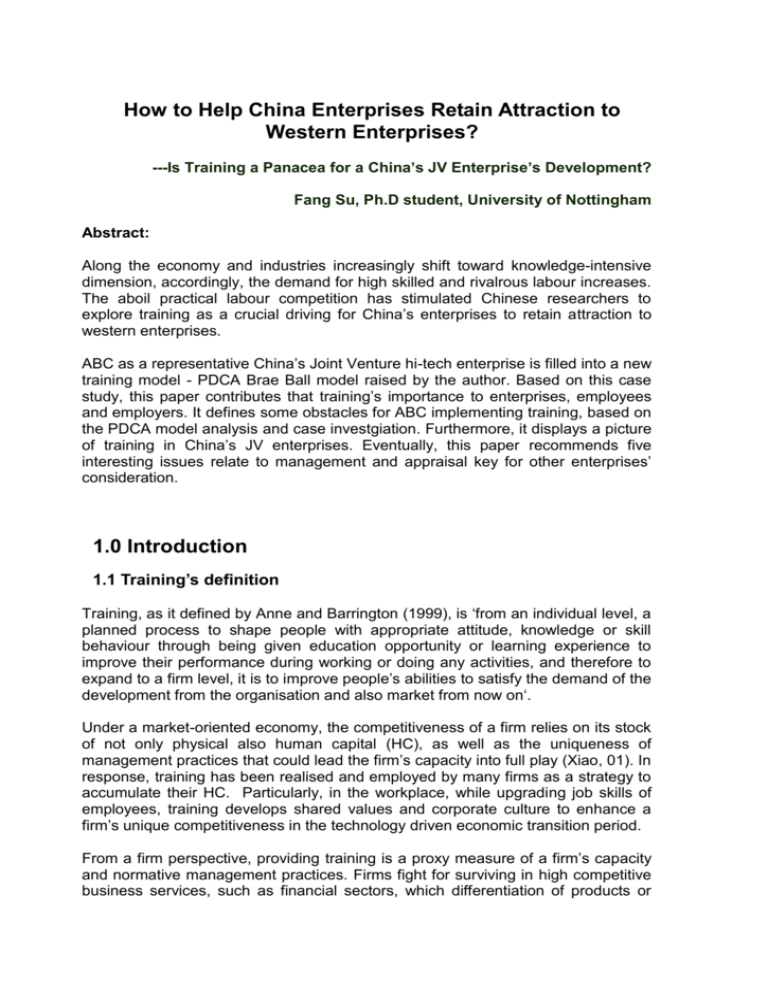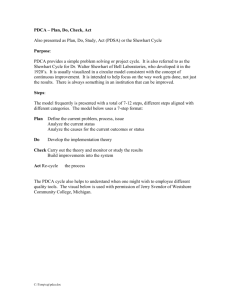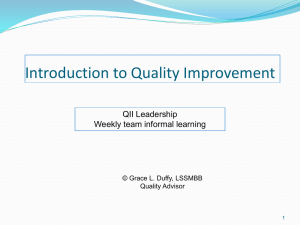How to Help China Enterprises Retain Attraction to Western
advertisement

How to Help China Enterprises Retain Attraction to Western Enterprises? ---Is Training a Panacea for a China’s JV Enterprise’s Development? Fang Su, Ph.D student, University of Nottingham Abstract: Along the economy and industries increasingly shift toward knowledge-intensive dimension, accordingly, the demand for high skilled and rivalrous labour increases. The aboil practical labour competition has stimulated Chinese researchers to explore training as a crucial driving for China’s enterprises to retain attraction to western enterprises. ABC as a representative China’s Joint Venture hi-tech enterprise is filled into a new training model - PDCA Brae Ball model raised by the author. Based on this case study, this paper contributes that training’s importance to enterprises, employees and employers. It defines some obstacles for ABC implementing training, based on the PDCA model analysis and case investgiation. Furthermore, it displays a picture of training in China’s JV enterprises. Eventually, this paper recommends five interesting issues relate to management and appraisal key for other enterprises’ consideration. 1.0 Introduction 1.1 Training’s definition Training, as it defined by Anne and Barrington (1999), is ‘from an individual level, a planned process to shape people with appropriate attitude, knowledge or skill behaviour through being given education opportunity or learning experience to improve their performance during working or doing any activities, and therefore to expand to a firm level, it is to improve people’s abilities to satisfy the demand of the development from the organisation and also market from now on‘. Under a market-oriented economy, the competitiveness of a firm relies on its stock of not only physical also human capital (HC), as well as the uniqueness of management practices that could lead the firm’s capacity into full play (Xiao, 01). In response, training has been realised and employed by many firms as a strategy to accumulate their HC. Particularly, in the workplace, while upgrading job skills of employees, training develops shared values and corporate culture to enhance a firm’s unique competitiveness in the technology driven economic transition period. From a firm perspective, providing training is a proxy measure of a firm’s capacity and normative management practices. Firms fight for surviving in high competitive business services, such as financial sectors, which differentiation of products or services is very necessarily important. In this context, relatively sophisticated models of HRM, high quality of employees with advanced skills and comprehensive capabilities, etc. have been taken into account for firms in longterm development perspectives (Boxall, 2003). In the contemporary context, it is meaningful to reveal the obstacles and challenges for China’s firms on how to accumulate more capacities to improve its HC quality. Based on an individual perspective, it could be summarised that the formal education provides the first platform of personal development, which build up fundamental competence at school. Continually; after landing to the workplace, training could help people to re-establish themselves another type of competence as the second platform of self-development. As a result, this paper keeps the standpoint that in a fast changing economic context, training programmes related to jobs are a means to readjust to the changing workplace and improve productivity. 1.2 Reasons of employees participating training Xiao et al. (2005) identified the reasons of employees participating training from individual psychological attributes, skill improvement, qualification enhancement, job mobility, and personal satisfaction as follows: (1) employees who actively pursued further training were those who had an awareness of the societal and institutional changes that has an impact on the workplace and the increasing demanding skill requirements that came with such changes; (2) in addition to societal changes, structural changes also occurred within the enterprises; (3) change in ownership, adaptation to the market economy, reorientation of strategies, and organizational restructuring have caused the enterprise to be a different kind of employer; to the employees, there appeared to be a new set structural requirements for them to satisfy; (4) instead of political rectitude, loyalty, compliance, and honesty, the enterprise has begun to value professional competence, initiative, positive work attitude, and efficiency (Xiao, 2005). Firm executives believed that employees of this kind were more eager to learn better of themselves and that their education and training should afford them greater adaptability and stronger ability to learn continuously, because in the eyes of executives, an employee’s potential could be judged by the kind of training he or she had achieved (Xiao, 2005). For those employees who were looking for mobility and advancement, further education and training not only served the practical purpose of skills development but also functioned as a possible indication of interest in mobility and advancement (Xiao, 2005). 1.3 Training development in China Since the start of economic reform, China’s government introduced a series of legislation to help the development of training. In 1979, some compulsory training courses for all potential managers have been provided by a national network of Cadre Management Training Institutes (Warner, 1992). In 1981, the State Council of China regulated that enterprises need to spend at least of 1.5% of the total wages on employees’ education and training (Lu, 1987). Few years later, in 1990, The Ministry of Labour enacted another statutory writ titled ‘The Regulations for Worker’s Technical Grade Examination’, which covers contents like workers’ attitude, performance and levels of skills. The regulations set up a formal system with combining the relevant issues of training, such as: testing, implementation and HR management (Cooke, 2004). Five years after, the ‘Temporary Regulations on Education for Professional and Technical Personnel in China’ was raised by the government, which is a profound improvement on paying attention of the continuing training from a national level, especially a remarkable development for high skilled employees (Cooke, 2004). On another hand, these new-raised regulations promoted a major momentum to workplace training for state-owned fields; but in an entire picture, training provisions still walked with the former pace of step, and also are disparity in cross-sectors (Cooke, 2004). The competitive business environment is another driving force for the training provision. Cooke (2004) suggested, for example, due to business booming in China, the enterprises need to converge with international practice, which has led to an increase in training provision to fulfil the international accreditation requirements, however the training is far from sufficient. Despite the absence of detailed training statistics to capture precise picture of workplace training in China, the training landscapes so far displays a number of characteristics and problems (Liu, 2000). It concluded: (1) low level of training provisions across-sectors; (2) the significant inter-sector difference between the secondary industrial and the third industrial sectors, with the former pay more attention in training than the latter; (3) considerable variations of training provisions amongst different ownership of enterprises; (4) regional difference in training provisions, with the enterprise in wealthier areas, such as the east and southeast, faring better in general than those in the north and west; (5) two-tier system of management and professional training and development versus mass workplace training, with the former being given a far high priority than the latter; (6) training is used as the substitute for workplace downsizing (Cooke, 2005b). Björkman and Lu (1997) stated in general, training is rather extensive in the hi-tech application and general management aspects in complete foreign-owned enterprises to state-owned ones. Regarding to joint ventures (JV), both technical and general management training are still remained with the previous style (Ng and Siu, 2004). Under this context, in order to explore the practical existing style of training in China’s enterprises, this paper contributes a training model for them. Furthermore, based on a hi-tech JV enterprise as a case study, it is to illustrate a picture of training in China’s JV enterprises from a different angle. 2.0 Training Model Some managers argue that training concept in some China’s enterprises is only empty talk, and it is neither effected practically by labour demand from market, nor connected with personal development needs. How to manage training and ensure its quality to enterprises become a profound thinking. The famous quality management concept derived from Deming in 1950, it is titled PDCA model. 2.1 PDCA Model The PDCA cycle is a dynamic model designed to drive continuous improvement to the quality of a system or a process by Deming. Another researcher Kaoru Ishikawa (1985) has expanded Deming's four steps into six as follows (see Graph 1): 1) 2) 3) 4) 5) 6) Determine goals and targets. Determine methods of reaching goals. Engage in education and training. Implement work. Check the effects of implementation. Take appropriate action. Graph 1: Kaoru Ishikawa’s 6 steps of PDCA Source: Ishikawa. K., (Lu. D. J. trans.), 1985, What is Total Quality Control? 2.2 PDCA cycle and recycle model As a developing country model, China is on the way of catching up to advanced countries, which means during the transition period, China’s enterprises are still exploring the appropriate and effective way of development. Stimulated by this train of thought, this paper selected another PDCA apply model based on China’s status quo, which improved by scholar Wang Yu Fang. It is called cycle and recycle model (see Graph 2), which contributes to how to manage different projects at the same time or observe one project in different steps of progress. Based on her theory, this "PDCA" management cycle characteristics could be summarised as follows: 1) sets small cycle could promote each other. On a "PDCA" cycle is the next level based on the PDCA cycle, the next level "PDCA" cycle is on an "PDCA" cycle of implementation and concrete. 2) continuous spiral. Four stages of the cycle to turn, the first of the new campaign is to increase the content and objectives of the cycle to solve the problem and improve the level of quality. 3) promote "PDCA" cycle, the key is summed up (A) stage. By summing up experience, affirming the achievements and defining insufficience to rectify the errors, which are "PDCA" cycle of continuous advance key. Graph 2: PDCA cycle and recycle model Source: Wang Yu Fang, "PDCA" cycle, and the promotion of recycling model 2.3 PDCA Brae Ball Model “Haier Group” is the largest consumer appliance maker in China, regarded as the "GE of China." It was a small factory on the berge of bankruptcy in 1984, but today, Haier has become an international powerhouse that is well on its way to building a global brand (Jeannie, 2003). Mr. Ruimin Zhang, the CEO of Haier Gourp thinks up novel and origional concepts on management, which are popularly quoted and employed by many scholars and enterepreneurs in China. The training implementation model below (see Grpah 3) is revised by the author, and is combined a “Brae Ball” management concept by Ruimin Zhang with the quality improvement PDCA concept from Wang Yu Fang mentioned above. Graph 3: PDCA Brae Ball model Traction power – Motivation - D Thrust power – Improvement - A Corporate strategy PDCA: P D A C Planning Do Check Act Resisting power – Appraisal -C Fundamental power - P: Training Planning - PDCA (Planning, Do, Check, Act) Source: Ruimin Zhang and Wang Yu Fang, and then amended by the author, 2008 2.4 The Four types power in the “Brae Ball” Concept 1) Fundamental power (P) - Planning The so-called fundamental power is the basis of training delivery within an enterprise, which is consist of training budge, mechanism and process. As a foundation in the whole cycle, it implys a small cycle of PDCA, which denotes Planning (fequency of training), Do (trainer/trainee/facilities/types of training), Check (apprisal) and Act (improvement). All this foundation is diven by training strategies. 2) Traction power (D) – Motivation Based on the “Brae Ball” concept, a good foreground of corporations is the premise, and also there should be still some potential for staff from diverse backgound to promote themselves. In this stage, motivation from senior, junior to noraml workers displays a crucial role. More specifically, the corporation culture could be the macro perspective of traction power; it covers the company’s values, the sense of mission, risks consciousness, innovation consciousness and etc.. Moreover, it could cover individual’s self-value, the sense of self-development, ability of innovation adaption, etc. from a micro perspective. 3) Resisting power (C) – Appraisal The key constraints of delivering training is lacking of effective appraisal, which possibly covers research analysis shortage, low quality of the internal trainers, poor facilities and other factors. Chinese saying that :”No rules, no circumference”. As a result, appropriate appraisal could supervise the process of training’s delivery, which reminds trainer and trainee to obey the disciplines. 4) Thrust power (A) – Improvement It says that “people only do what you inspect, not what you expect”. In fact, a number of corporate training modules did not match HR’s modules; hence it results in lacking of amalgamation. The function of checking is to make sure everything is on the right track, to correct and improve the implementation of training at once, if not. 3. Methodology This paper encircles this training implementation model as a framework, then selects one representative case study to fill in, so that it attemps to examine whether it could be employed in China’s enterprises to improve their training implementation. 3.1 Research methods Due to the absence of detailed training statistics in China’s enterprises, case study could be an ideal attempt when some answers are collected and analysed from ‘how’ and ‘why’ questions, additionally, when the event is designed under the author’s control, and focused on a practical phenomenon (Yin, 1994). Even if case study lacks of generalizability, an anonymous hi-tech JV company (called company ABC in this paper) is focused as an obvious representative case on China’s training issue; luckily the author’s friend Ke has get involved with the process of delivery interviews in China. The hi-tech JV company ABC is founded in 1993, and its core products include TFT-LCD Display, Mobile display systems, Precision electronic components & materials, and etc.. These products enjoy the leading position in the domestic and international market. The company has typical diverse work division (31 deparments) and employees (over 3000) from minxed background, the detailed data is following. Work division Number Proportion Technology Profession Marketing R&D al skills personnel 288 1035 196 2.92% 10.51% 1.99% Educational background Doctor& Master Management personnel 770 7.82% Bachelor Financial personnel 159 1.35% Production personnel 133 72.60% Junior College Vocational School Graduate Others Others 277 2.81% Number Proportion Post-Doctor 31 0.31% 261 2.65% 1235 12.54% Graduate 1401 14.23% 4349 44.16% 2571 26.11% Source: ABC. Annual Report, 2006 Another concern is that ABC company committed to employee-oriented human resources policies, and is fully highlighted training and development of each employee. The objective of training and development programmes provision is to satisfy the current need as well as cater the future expectation. In ABC, all employees need to take a short period job entry training course when they first enter to the company. Concequently, this research selects ABC as a representative case study to look at its existing training situation, and then put it into the PDCA Brae Ball model to explore a picture of its training. Perhaps it could recommend some practical outcomes for other companies to good use in the future. Through interview, the author can collect more explored answers according to their background, work experience, and the reasons for employees satisfying or dissatisfying training from diverse respondents. During the investigation, the author interviews 16 staffs including 14 employees and two department leaders from different departments. 3.2 Key interview questions The basic four primary interview questions are designed based on the four powers of Brae Ball model and four elements of PDCA as follows: 1) What kinds of and how frequency of the training you received? - P 2) Whether you are fully motivated towards training (e.g. promotion, salary increasing)? - D 3) Whether you satisfy the training? If so, in which way (e.g.contents, support from managers)? - C 4) What could be improved on training activity? - A 4. Research Findings and Discussions In this part, detailed research findings explore the factors influenced training within the four powers and the four parts (PDCA), namely, the Fundamental powertraining planning, Traction power-training motivation, Resisting power-training appraisal and Thrust power-training improvement. 4.1 Fundamental power (P) – Planning As its human resources policy mentioned ‘employee-oriented’, ABC fully realized the importance of training and provide different levels of training activity for their employees to improve their skill and knowledge. Firstly, all the employees received training, but the length of training is different, according to their working time. The employee, who worked in the company for four years received training for two months, and another one who worked only one and half years, was provided training for several days (see table1). Secondly, the company provided different length of training for the employees from different departments. The employees in charge of product planning received training for three months, the staffs worked in the international trade only received training from several hours to several weeks (see table2). As it mentioned before, the fundemental power could be decomposed another cycle of PDCA, namely Planning (fequency of training), Do (trainer/trainee/facilities/types of training), Check (apprisal) and Act (improvement). Table 1. Training time with working time - Planning Working Time 4 years 3 years 2 years 1 years Training Time 2-3 months 1 month 2 weeks to 6 weeks Several days Table 2. Training time allocated in different departments Department Training Time Technology 1 month-3 months Manufacturing 2 weeks – 1month IT 2 weeks for normal training and 6 weeks for speciality training Sales 4 days International Trade 1 hour per day Research and Development 1 month -3 month Varieties of training provided to different departments, in terms of characteristics of their duties defined by ABC. Technology department focus on the professional technical training, such as TET-LCD knowledge; Manufacturing department mainly provide TFT knowledge, safety knowledge; Sales department provide market orientation and sale skill training. More details please see table 3. Table 3: Types of training provided to different departments - Do Department Technology Department Manufacturing Department Sales IT Types of Training technical, such as TET-LCD knowledge, ISO, SPC control, Office SW TFT knowledge, safety knowledge market orientation, sales skills, management focus on technical training, know the whole process of machine manufacture, Research and Development International Trade management overseas training, mangaement Product knowledge training, work skill, foreign language, magement Training appraisal – Check, and improvement - Act are merged into the two power: Resisting power and Thrust power, which are interpreted as follows. 4.2 Traction power (D) – Motivation According to expectancy theory, employees should be more willing to work hard toward training objectives, if they feel they will be rewarded, will receive appropriate incentives, for doing well on the programme-which includes putting into effect what they have learnt back on the job (Lawler et al 1990). Being appropriately rewarded-through the provision of intrinsic and extrinsic incentives-for doing well, should also cause employees to think highly of the training programme ‘responsible’ for the rewards being available to them in the first place, and if employees regard training highly, it is ‘easier’ for them to justify receiving any regards they do; it also provides them with an indirect way of ‘thanking’ the organization for giving them these rewards, in the first place (Noe 1986; Deci 1975). As evidence in the research, most respondents do not think the training can help them to get a better earnings and the promotion. In other words, employees are not fully motivated towards training. One respondent said: ‘Objectively, getting better salary depends on what training contents you took and how deeply you got through the training. About the promotion, training will be taken after you get the promotion.’ It suggested that not all the provided training leads to higher pay, may be only ‘professional training’ can do. Santos and Stuart (2003:37) argued employees’ motivation and commitment towards their own personnel development was found to be significantly associated with the perceived impact of the training on non-monetary rewards. In this research, employees who associated training with better promotion prospects and personal career exploration were more satisfied with the training and their own job, and far more eagerly to engage them in proactive behaviour towards personal development such as continuous work performance improvement. As an employee said: ‘Training definitely can lead me to explore my personal development, it makes me be more courageous and more united. It motivates me to do great performance, and I think the long and effective encourage should be carried out by training and other ways.’ 4.3 Resisting power (C) – Appraisal The trainees’ satisfaction could be the best measurement of the training. During appraisal, some problems has been discovered. Firstly, it showed the response of employees to the training tended to be more satisfied with the extension of the training. The employee whose training time is short seems to be unsatisfied the training. It’s very obviously time is the biggest factor. One staff said: ‘Though it provides training by daily, the training is too short which only lasts half to one hour. During the training time, I can not fully take part in the training.’ Another staff said: ‘I do not satisfy the training for its limited contents because of its time limit.’ Second one is that the managerial training and personal development has not integrated into the daily training activity. Some interviewees found it difficult to transfer the training to the real job. ‘During the training course, everything makes sense. But after training, you go back to the office and realise that it is difficult to apply what you trained to the real job.’ One employee said. In generally, for most interviewees, training increased their confidence and self-efficacy, and it helped to improve their competencies, skill and work performance. In general, employees are more satisfied with the technical training than the managerial training, because the company pays more attention to the front one. Training ultimately serves for the need of the enterprise. In ABC, it increased emphasis on high quality products and services to face the rapid changes in the business environment, it is acquiring more and more employees with the relevant skills and high competence. Hence, it allocates lots of training resources to the technical training, including basic knowledge and upgrading skills. From the investigation, most interviewees responded: ‘it seems the training content lacks of the personal development, and, in fact, only the technical skill training can not meet our needs. We do need personal development.’ Employees themselves are increasingly demanding that their employers provide them with all the training they need to perform not only their current jobs, but also any related ones they may hold subsequently within the organization and outside, sometimes even as part of the informal contract of employment (Orpen 1998:35). However, it is difficult to design the personal development programme for individual employees. In the research, the satisfactory of provided training in technology department is higher than in other departments. It’s partly because the line manager of the technology department directly guide the employees’ daily work and responsible for on-the-job training. An interview responded: ‘The leader of my department supports training. He directly guide the technical training, at the same time, he will adjust training content according the change of the skills. During the weekend, he attends the personal development training as well. It motivates me to take part in the training actively, even I need pay money for the training by myself.’ Besides, the line manager’s personal involvement in training decisions, and in formal training events, and their own self-development practices, offers an example to ambitious subordinates. Moreover, Santos and Stuart (2003) argued, accordingly, where line managers were highly involved in discussing training needs, setting goals and reviewing progress and providing coaching and guidance, training was more likely to have a favourable impact on employees’ motivation, job satisfaction and personal growth. Surprisedly, it was found that in ABC some line managers perceive the training as extra burden. ‘More urgent work have to be given priority’ and ‘general pressure’ are the usual reasons for managers not involving in training. As one leader of the department puts it: I have to face and deal with a heavy load of work everyday. I need to control of the operation of the task, maximized the productivity and profit level, and improved the product and service quality, now I found myself responsible for motivating and developing my staff. All the tasks need to devote lots of my energy and time. While the standard of appraisal and reward is the achievement of the productivity in the limited time, not including the training employees. 4.4 Thrust power (A) – Improvement After some problems being explored in the parts above, some improvement could be made in ABC. In ABC, different departments are responsible for different types of training. HR department is responsible for the overall training; Quality Control department is in charge of quality management training, in additional, technology department more focuses on the related technology training. Along with the strategy made by the HR department, each department could define their training needs through collecting and summarising employees’ needs first, and then focuse on the on the job training, and also arrange training time flexibly. In another word, training contents could be contributed by trainees, for instance, IT staff could be provided training on personal development training to help them revalue themselve, as long as they are willing to do it. Meanwhile, following up training is so necessary that the trainees could transfer the knowledge delivered via training into work, even if they are unable to transfer, the following up training session could push or pull them to grasp the training application. In ABC, according to the levels of the training, the enterprise could allocate the training time reasonably, which combine the on-the-job training and off-the-job training together. Some of the training is arranged in the working time, such as solving the problem which may arise in the daily work, positions skill training; some training is taken after work time, which more focus on the personal development and knowledge. Due to the poor linkage between the training and motivation, employees are not satisfied with the provided training. A respondent from IT technology said: ‘Monetary rewards, such as better pay and promotion is not the only motivator to engaging me into the training activity, but it’s the most direct way to make me realize the value that training brings.’ Employees are less likely to see training as leading to high pay, better promotion prospects. Employees’ motivation and commitment towards their own personal development was found to be significantly associated with the perceived impact of training on non-monetary rewards, the perceived impact of training on job satisfaction, motivation, personal growth and job performance was significantly related to the individual’s commitment to personal development (Santos and Stuart 2003:37). 5.0 Conclusion and Recommendations Summing up this case study, ABC does have a commitment to training, and it concludes the employees’ response as the following five points: (1) time is an important factor to influence the employees’ satisfaction to the training, the employee who receives the longer time training seems more satisfied than the employee with short training time; (2) employee from different departments show different levels of satisfactory; (3) employees are not fully motivated to taking actively part in training, because the better pay and promotion poorly linked to the training;(4) employees are less satisfied with the managerial training and personal development; (5) although the provided training is not as perfect as the employee expected, most interviewees responded the training does increase their confidence and self-efficacy to some extent, and it helpful to promote their skills, competencies and work performance. Although ABC widely recognizes the importance of the training, not only for the employee-improve the skill, increase the self-esteem, realize their own potential, bus also for the employer, the enterprise-productivity, profit, prosper the business, in reality, there are more or less obstacles to implementing training. It is just a single case study, thus it can not illuminate the overall training in China, but it can represent the training operation in some JV enterprises in China. In conculsion, the barriers explored from ABC are connceted to the main clues based on the PDCA Brae Ball model, namely the Thrust power – Improvement, which indicates training is not managed effectively on the right track; and another one the Resisting power - training appraisal, which denoted that it lacks the performance appraisal to measure the outcome of the training. Even if the operation of training in some JV enterprises in China is still problematic, in reality, it still has space to improve the training. There are five interesting issues relatively to management and appraisal being recommonded as follows. Perhaps these issues could recommend some practical outcomes for other JV enterprises to good use in the future. 5.1 Training investment and risk management Yu (2005) suggested firms are willing to share the cost of off-the-job training; moreover, although specific human capital increase technical efficiency within firms, general human capital and basic research increase the profitability of innovation and therefore benefit the society at the macro level, at the same time, the value of off-the-job training is not limited to its transferable elements. To judge whether the training investment is worthy, it is firstly better to recognise potential risks. It’s difficult to guarantee the gain from the training, so cheaper alternative to training might be to poach instead. According to Moen and Rosen (2004), there exists two types of firms; training firms which have a comparative advantage in providing general training, and poaching firms which have a comparative advantage in utilizing general human capital. It means poaching normally happen in the company which provide general training. However, there’re some firms provide general training. Milgrom and Roberts (1992) offered the following explanation for such behavior: Suppose there is an opportunity to invest in general (non-specific) human capital, but that employees cannot afford to absorb the costs of training themselves. An obvious solution would be for the employer to finance its employees’ marginal product for some period of time. The problem is that another firm might be willing and able to make an attractive job offer that destroys the agreement. A financial penalty of just the right magnitude would discourage the employee from leaving just to capture the value of training, but would still permit the employee to leave if he or she really were more valuable to the other employer. Thus, for example, some firms that undertake their employees’ study for graduate degrees formally lend them the tuition. The company then forgives the debt if the worker stays with the firm for a predetermined period after graduation. The loan may, however, become payable in full if the employees quits before the requisite period has expired. Another explanation is, at least to some extent, the most general training is inseparable from firm-specific training (Araki 2001). In term of this explanation, the provided training can help to improve firm-specific skills and general skills at the same time. Accordingly, if the firm offers the sufficient high salary to the employees, it can help to retain the trainees. And the firm can obtain some profits (Araki 2001). In reality, as long as the firm is able to resolve internal efficiency, the risk-‘poach’ at least can be decreased, otherwise, it will lead to underinvestment in training, such as excessive turnover, which reduce the return of individual and organization from training. (Araki 2001). 5.2 Teamwork training Taking the teamwork training as an example, it usually provides teamwork training after working time, thus, employees found difficult to transfer the teamwork skills to the workplace. In ABC, it’s important to share and exchange the technology information, especially in the technology department. Teamwork can increase the cooperation between the employees under different technology work, thus improve their work involvement. It observed that employees working within team participatory work, have more responsibility and autonomy and feel themselves to be more skilled as a result of the broader experience and the training undergone to full the wider range of duties (Bacon and Blyton 2003:13). In additional, there’re evidence found that workers in more participatory work systems are more likely to receive both formal and informal training than their counterparts in organizations with more traditional work system (Appelbaum 2000:208). It suggests that teamwork motivates the staff to receive the training in order to promote their work involvement and commitment. 5.3 Strategy motivation Keep (2005) suggested in two circumstances, it is so hard to adjust training to strategy that strategy is a rapidly moving target: (1) many organizations, particularly SMEs, appear to lack of strategies which could be defined in details, and stably relevant to elements during planning, and in some cases, even in large firms, a detailed, explicit business strategy may be lacking, with the business being managed through portfolio techniques, whereby the corporate centre establishes profit targets for its business units (Purcell, 1989), thus there is no central blueprint, merely the incentive that those that do well may receive investment, while those that do not are liable to be sold; (2) where strategies exist, they may be so unstable as to render meaningful planning of HRM and training issues impossible, the continuing tendency for organization to walk on the currently existing “right” track with applying the unstably changed programmes run by senior manager, more emphases on adjustment of the latest management fashion (Bach and Sisson 2000). 5.4 Managerial constraint As Keep and Rainbird (2000:184-5) argued, leaders from different departments are still in the role transition, from the traditional roles (controller, giver of orders, arbitrator between competing claims) to the different role of mentor, coach, learning facilitator. In ABC, the employee training and their personal development is not linked to the department leader’s appraisal and reward, thus, leaders are tend to take the training issue out of their working agenda, due to their work performance is measured by the profit and productivity of the goods. Orpen (1999: 41) suggests that managers who directly responsible for training should provide the necessary time, money, equipment, facilities, and opportunities for the training, and take deliberate steps to ensure that the employees concerned believe the resources provided are enough, or at least adequate. In this respect, if training can not be properly resourced, it seems that firms may be better not to offer training at all, at least in the eyes of the trainees themselves (Knowles 1994). Furthermore Orpen (1999:41) found that employees are unlikely to be motivated for training or to believe training is of high quality if they feel, that the organization has not made enough time available, or believe that too little money has been provided. He suggests managers who responsible for training must not only provide training outcomes that employee values, but must make them contingent on employees making the effort necessary for them to really benefit from the training. 5.5 Performance appraisal Improvement Keep (2005) suggests that training activity should be the outcome of a high degree of integration with the organization’s strategy planning, performance management and appraisal mechanisms. Performance appraisal could benefit an organization and employee in a number of ways such as an increase in staff self-esteem and staff motivation to perform effectively; management could gain new insight into staff and supervisors; job functions and responsibilities are clearly defined; performance appraisal also could develop valuable communication between employees and managers; performance appraisal also could encourage increased self-understanding of performance standard among staff as well as insight into the kind of development activities that are of value; performance appraisal could distribute rewards on a fair and credible basis; the organizational goals can be readily accepted, and finally performance appraisal could improve institutional/departmental manpower planning, test validation, and development of training programs (Mohrman, Resnick-West and Lawler, 1989). Performance appraisal can also help to improve employees’ job performance by identifying strengths and weaknesses and determining how their strengths can be best utilized within the organization and weaknesses overcome. Performance appraisal also can provide information for Human resource planning to assist succession planning and to determine the suitability of employees for promotion (Armstrong, 1998). For the employer or the trainer, they will get the information such as whether the trainee satisfy the training, whether the training content suitable to the employee, to the changed economy. If not, the employer or the trainer can adjust the training content to meet the changeable needs. Keep (2005) argued in terms of performance and appraisal, the ideal is for the individual worker to have his or her performance appraised, skill gaps and deficiencies identified, and then a personal development plan formulated (usually by their line manager) to remedy these deficiencies and to develop the individual to fit their next role within the organization. References: Anne, M.; and Barrington, H. (1999), Training Interventions: Promoting learning opportunities. London: Chartered Institute of Personnel and Development. Appelbaum, E., Bailey, T., Berg, P. and Kalleberg, A. (2000). Manufacturing Advantage: Why High-Performance Work Systems Pay Off, Ithaca: Cornell University/ILR Press. Armstrong, M (1998) “Performance Management: key strategies and practical guidelines”. Bacon, N. and Blyton, P.(2003) The impact of teamwork on skills: employee perceptions of who gains and who loses. Human Resource Management Journal. 13(2), PP.13-29. Björkman, I.; and Lu, Y. (1997), Human Resource Management Practices in Foreign Invested Enterprises in China: What has been learned, in Stewart, S. and Carver, A. (eds.) Advance in Chinese Industrial Studies. Vol. 5. Greenwich, CT: JAI Press, PP.155-172. Boxall, P. (2003), HR strategy and competitive advantages in the service sector. Human Resource Management Journal, 13(3), PP.5-20. Cooke, F.L (2004), HRM in China, in Budhwar, P.S(ed). Managing Human Resources in Asia-Pacific. London: Routledge. Cooke, F.L. (2005a), Vocational and Enterprise Training in China: Policy, Practice and Prospect. Journal of the Asia Pacific Economy. 10(1), PP.26-55. Cooke, F.L. (2005b), HRM, work and employment in China. London: Routledge. Deming's 1950 Lecture to Japanese http://deming.eng.clemson.edu/pub/den/deming_1950.htm Management, Ishikawa. K., (Lu. D. J. trans.), 1985, What is Total Quality Control?, Prentice-Hall Inc., Englewood Cliffs, NJ. Jeannie J. Yi, & Shawn X. Ye, (2003), The Haier Way: The Making of a Chinese Business Leader and a Global Brand, Homa & Sekey, US Keep, E. ;and Rainbird, H. (2000), Towards the Learning Organization, in Bach, S and Sission, K (eds.), Personnel Management (3 rd edn), Oxford; Blackwell, PP.173-194. Keep, E. (2005), Skills, Training and the Quest for the Holy Grail of Influence and Status, in Bach, S. (eds.) Managing Human Resource (4th.). Blackwell Publishing, PP.211-236. Lawler, E.E., Porter, L.W., and Hackman, J. (1990) Behaviour in organization. NewYork:McGraw-Hill. Liu. L. X. (2000), Employees training in SOEs in China. Enterprise Operation and Management, 7, PP.63-67. Lu, H.J. (ed.) (1987), Enterprise labour management, Beijing: China Labour Press. Milgrom,P. and Roberts, J. (1992). Economics, Organization and Management. Prentice Hall International Moen, E.R. and Rosen, A. (2004) Does poaching distort training? Review of Economic Studies, 71, PP.1143-1162. Ng, Y.C. and Siu, Noel Y. M. (2004), Training and enterprise performance in transition: evidence from China. International Journal of Human Resource Management. 15(4), PP.878-894. Noe, D.A. (1986) Trainee attributes and attitudes: Neglected influences on training effectiveness. Academy of Management Review, 11, PP.736-749. Orpen, C. (1998) The influence of the training environment on trainee motivation and perceived quality. International Journal of Training and Development. 3(1), PP34-43. Purcell, J. (1989), “The impact of corporate strategy on human resource management”. In Scorey, J. (Ed.), New Perspectives on Human Resource Management, London: Routledge, PP. 67-91 Santos, A. and Stuart, M. (2003) Employee perceptions and their influence on training effectiveness. Human Resource Management Journal, 13(1), PP.27-45. Warner, M (1992), How Chinese mangers learn, London: Macmillan. Wang Yu Fang, et al. (2003), Quality analysis, quality improvlment and Statitics techniques, China Estimation Publish Xiao, J., Lo, K, Leslie N.,; and Lai, MH. (2005), Learning to Work in China’s Leading Metropolis. Teachers College Record, 107 (6), PP.1335-1369. Yin, R.K., (1994), Case study research: design and methods. Second edition. London: Sage. Yu, Z.X. (2005) Workplace Training and Human Capital: Livelihood Protaction and Promotion in Urban China. Teachers College Record, 107(6), PP.1370-1992. Website: www.szboe.com http://www.dfes.gov.uk/skillstrategy/uploads/document/21st%20Century%20skills.p df http://www.eemarketdata.com/home/index.aspx?PageID=101250&url=http://www.boelcd.com http://www.cecceda.org.cn/english_version/enterprises%20and%20entrepreneurs/qiyejia/zhangrui min.htm http://www.businessweek.com/1999/99_24/b3633071.htm http://www.haier.cn/about/culture_index_detail18.shtml









